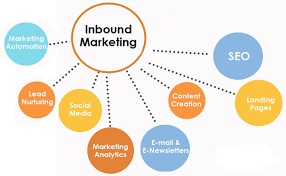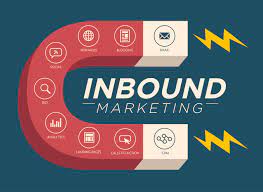Inbound Digital Marketing: Unleashing the Power of Online Engagement
In today’s digital age, businesses have to constantly adapt to the ever-evolving landscape of marketing strategies. One approach that has gained significant momentum is inbound digital marketing. Unlike traditional outbound marketing, which involves pushing advertisements and messages out to a wide audience, inbound digital marketing focuses on attracting and engaging potential customers through valuable content and personalized experiences.
So, what exactly is inbound digital marketing? At its core, it’s about creating a seamless online journey for your target audience. It involves leveraging various channels such as search engines, social media platforms, email campaigns, and content creation to draw prospects in and nurture them into loyal customers.
One of the key elements of inbound digital marketing is providing relevant and useful content that addresses the pain points and interests of your target audience. By offering valuable information through blog posts, videos, e-books, or podcasts, you position yourself as an authority in your industry while building trust and credibility with potential customers.
Search engine optimization (SEO) plays a vital role in inbound digital marketing as well. By optimizing your website with relevant keywords and ensuring it meets search engine guidelines, you increase your chances of ranking higher in search results. This helps drive organic traffic to your site from people actively searching for information or solutions related to your products or services.
Social media platforms have become powerful tools for inbound digital marketing as they allow businesses to engage directly with their audience. By creating compelling social media posts and running targeted ad campaigns, you can attract users who are most likely to be interested in what you offer. Social media also provides an avenue for building relationships with your customers through conversations, feedback, and sharing valuable content.
Email marketing remains a crucial component of inbound digital marketing as well. By capturing leads through opt-in forms on your website or landing pages, you can nurture those leads by sending them personalized emails based on their interests or actions they’ve taken on your website. This personalized approach helps build trust and keeps your brand top-of-mind.
Inbound digital marketing is not only about attracting and engaging prospects; it’s also about analyzing data and measuring the effectiveness of your efforts. By monitoring key metrics such as website traffic, conversion rates, social media engagement, and email open rates, you can gain valuable insights into what strategies are working and make data-driven decisions to optimize your campaigns.
The beauty of inbound digital marketing lies in its ability to adapt and evolve. With the constant advancements in technology and changes in consumer behavior, businesses need to stay agile and keep up with the latest trends. By embracing inbound digital marketing, you can create a holistic online presence that resonates with your target audience, drives quality leads, and ultimately boosts your bottom line.
In conclusion, inbound digital marketing is a powerful approach that focuses on attracting, engaging, and delighting customers through valuable content and personalized experiences. By leveraging various channels such as search engines, social media platforms, email campaigns, and data analysis, businesses can create meaningful connections with their target audience while driving growth. So why wait? Embrace the power of inbound digital marketing today and unlock the full potential of online engagement for your business.
Common Inquiries about Inbound Digital Marketing: Explained
- What are 3 types of inbound marketing?
- Is inbound marketing a form of digital marketing?
- What is an example of inbound marketing?
- What is inbound marketing vs digital marketing?
What are 3 types of inbound marketing?
There are several types of inbound marketing strategies that businesses can employ to attract and engage their target audience. Here are three common types:
- Content Marketing: Content marketing involves creating and distributing valuable, relevant, and consistent content to attract and retain a clearly defined audience. This can include blog posts, articles, videos, podcasts, infographics, e-books, and more. The goal is to provide information or entertainment that addresses the needs and interests of your target audience while positioning your brand as an industry expert.
- Search Engine Optimization (SEO): SEO is the process of optimizing your website and its content to improve its visibility in search engine rankings. By targeting specific keywords relevant to your business, optimizing on-page elements such as meta tags and headings, building quality backlinks, and providing a positive user experience on your site, you increase the chances of appearing higher in search results. This helps drive organic traffic from people actively searching for products or services like yours.
- Social Media Marketing: Social media marketing involves leveraging various social media platforms to engage with your target audience, build brand awareness, and drive traffic to your website or landing pages. By creating compelling content tailored for each platform, interacting with users through comments and messages, running targeted ad campaigns based on demographics or interests, and analyzing data to refine your strategies, you can effectively reach and connect with potential customers.
These three types of inbound marketing work together synergistically to attract prospects by providing valuable content through various channels such as search engines and social media platforms. By focusing on creating meaningful connections with your target audience through informative content, optimizing for search engines to increase visibility, and leveraging social media platforms for engagement opportunities, you can effectively drive traffic to your website and nurture leads into loyal customers.
Is inbound marketing a form of digital marketing?
Yes, inbound marketing is a form of digital marketing. Inbound marketing utilizes various digital channels and strategies to attract, engage, and convert potential customers. It focuses on creating valuable content, optimizing websites for search engines, leveraging social media platforms, and utilizing email marketing to drive organic traffic and nurture leads. Inbound marketing aligns with the principles of digital marketing by utilizing online platforms and technologies to reach and engage with target audiences effectively.
What is an example of inbound marketing?
An example of inbound marketing is creating a blog that provides valuable and informative content related to your industry or niche. Let’s say you run a fitness equipment company. You could create a blog where you share articles on topics like workout tips, healthy recipes, and fitness trends. By consistently publishing high-quality content that addresses the interests and needs of your target audience, you can attract organic traffic to your website.
As people search for information or solutions related to fitness, they may come across your blog posts through search engines like Google. They find value in the content you provide and begin to see your brand as an authority in the fitness industry. Over time, they may explore other sections of your website, such as product pages or subscribe to your newsletter.
Through this inbound marketing approach, you have successfully attracted potential customers who are genuinely interested in what you offer. By nurturing these leads with additional relevant content or special offers via email marketing or retargeting ads, you can further engage them and guide them towards making a purchase decision.
The key aspect of inbound marketing is that it focuses on building trust and establishing a relationship with the audience by providing value rather than directly promoting products or services. This approach helps create a positive brand perception and increases the likelihood of converting leads into loyal customers.
What is inbound marketing vs digital marketing?
Inbound marketing and digital marketing are two distinct but interconnected concepts in the realm of modern marketing strategies. While they share similarities, it’s important to understand their differences.
Digital marketing is a broad term that encompasses all forms of marketing efforts conducted through digital channels. It refers to any promotional activity that utilizes electronic devices or the internet to reach and engage with an audience. Digital marketing includes various tactics such as search engine optimization (SEO), social media marketing, email marketing, content marketing, pay-per-click advertising, and more. The primary goal of digital marketing is to promote products or services using digital technologies and platforms.
On the other hand, inbound marketing is a subset or approach within digital marketing. It focuses specifically on attracting customers by providing valuable content and personalized experiences rather than interrupting them with intrusive advertisements. Inbound marketing aims to create meaningful connections with potential customers by addressing their needs and interests through informative blog posts, videos, podcasts, social media engagement, email newsletters, and other content-driven strategies. The main objective of inbound marketing is to draw prospects in naturally and nurture them into becoming loyal customers.
In summary, while digital marketing encompasses a wide range of online promotional activities across various channels, inbound marketing is a specific methodology within digital marketing that emphasizes creating valuable content and engaging experiences to attract and retain customers. Inbound marketing can be seen as a strategic approach within the broader scope of digital marketing that focuses on building relationships and delivering value to customers throughout their buyer’s journey.


